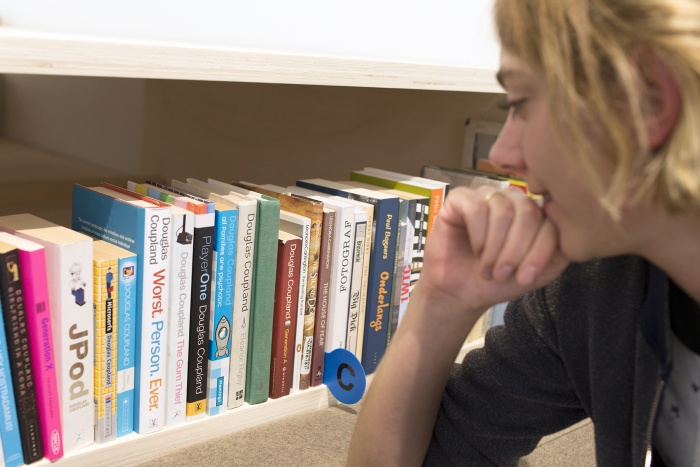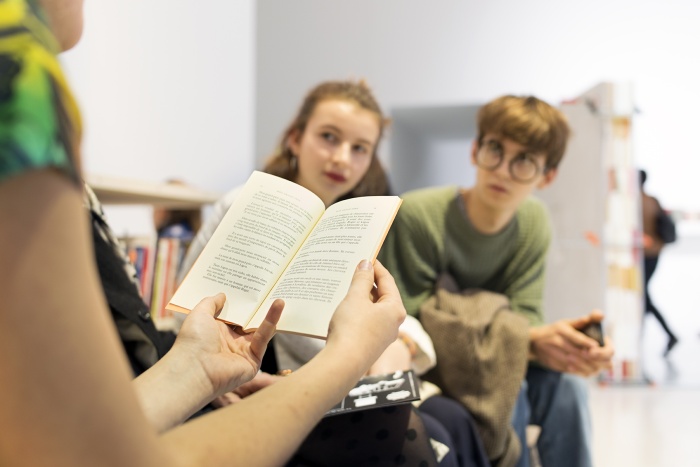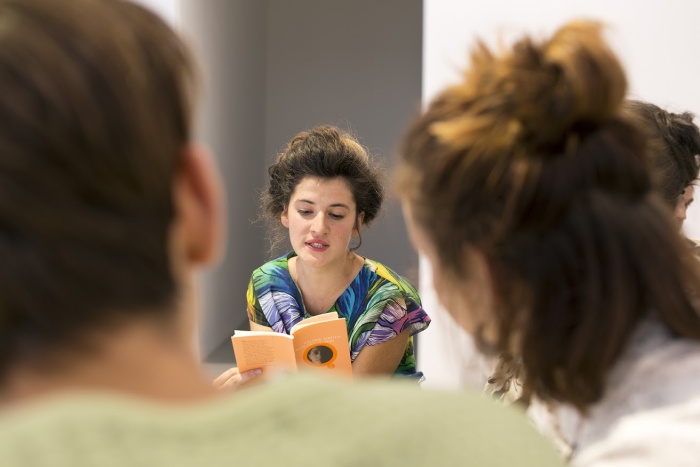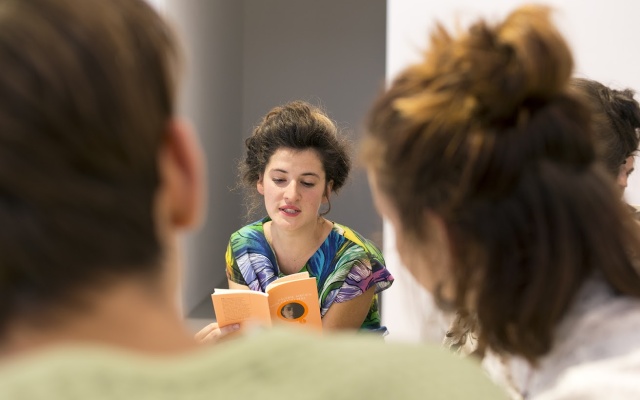In a recent conversation, Clive Phillpot speaks about the categories that he created in “trying to indicate the wealth of material that might be embraced by the term ‘artist book,’” and speaks of them as “mongrels.”1 Though it is not our intention to participate in the old discussion around the artist’s book, Phillpot’s words will lend us a hand with elucidating the crossover between the visual arts and literature. A preliminary look at the history of such a crossover immediately causes the word “mongrel” to pop up in our minds, insofar as these two disciplines are defined precisely by the impossibility to reach a consensus about what they are. Any attempt at definition is bound to fail – the moment one is given, a new practice will emerge that expands and challenges it.
The Book Lovers. Instalacja performatywna, część wystawy "Montag ou la bibliothèque à venir". Frac Franche-Comté, 2017. Dzięki uprzejmości M HKA. Zdjęcie: Nicolas Waltefaugle.
Whereas fiction would be the lowest common denominator in literature,2 it has been long obliterated from critical discourse in the visual arts. The introduction of literary traits constituted an unacceptable hybridisation for an influential strand of modernism, known as medium-specificity (led by critic Clement Greenberg), and therefore a crucial factor in having remained ignored for so long. However, in recent years, fiction has become a pervasive notion in art practice, coinciding with what Rosalind Krauss identifies as the rise of a post-medium condition, where the division between genres and disciplines is no longer productive nor desirable.3 Hybridisation, impurity, and contamination are embraced by art practitioners who resist confinement to the formal exploration of a single discipline.
At the same time, there is an abundance of pointers to a sense of exhaustion in the language that we use to speak, write, and read in and about contemporary art, e.g. the crisis of contemporary art criticism; the phenomenon known as International Art English; and the widespread suspicion that art theory is no longer a satisfactory means to engage with the artistic experience. The advent of fictocriticism, the propagation of the artist’s novel, and the increasing interest in experimental forms of creative criticism are unequivocal symptoms of the emergence of a hybrid textual space where traditional distinctions between theory and practice, fiction and research, literature and the visual arts, are blurred. The only trait common to such a disorganised array of writing practices lies in the fact that they are mongrels of all sorts of breeds and colours.
Since 2011 we, artist David Maroto and curator Joanna Zielińska, have collaborated under the name “The Book Lovers” on a research project about the artist’s novel. In 2016–18 we commissioned the production of a new artist’s novel (Tamam Shud) with the support of the Ujazdowski Castle Centre for Contemporary Art in Warsaw. Obieg magazine no. 8: “Art & Literature: A Mongrel’s Guide” is inscribed within the same trajectory, expanding on the notions inaugurated by our previous research, favouring a sort of art predicated on process and subjectivity, and the renewal of art language. Our editorial line strives to emphasise hybridisation not only at the level of genres and disciplines, but also in terms of a mixed authorship in the texts selected and commissioned. Hence our interest in conversations and artistic dialogues. 
The Book Lovers. Instalacja performatywna, część wystawy "Montag ou la bibliothèque à venir". Frac Franche-Comté, 2017. Dzięki uprzejmości M HKA. Zdjęcie: Nicolas Waltefaugle.
Chris Kraus’s seminal novel of theoretical fiction, I Love Dick (1997) has been dubbed a “fusion of gossip and theory.”4 Mark von Schlegell’s novel of speculative fiction, New Dystopia (2011), served as the catalogue of the homonymous exhibition by him curated at the CAPC Musée d’Art Contemporain de Bordeaux. Both writers taught a course together on fictocriticism at the San Francisco Art Institute, which is the central subject of Beyond Fictocriticism, a conversation especially commissioned for this issue. Fictocriticism is a writing mode originated in academia, whose multidisciplinary approach, as Carl Rhodes claims, seeks to “blur the boundaries between the fictional, the factual and the theoretical.”5 Rhode’s reflexion serves to explain why, in fictocriticism, fiction writing becomes more than a question of style, it is methodological – it is writing as research.
In June 2011, Cally Spooner began an eight-month art project in International Project Space, a public gallery in Birmingham. The project revolved around the writing of an artist’s novel called Collapsing in Parts, structured in eight parts corresponding to the eight-month scheme. The project culminated with the publication of the artist’s novel, a solo exhibition, and a feature-length film. In The Book Lovers, we have always considered Spooner’s use an exemplary case of the artist’s novel employed as a medium in the visual arts, a circumstance that led us to collaborate with her in our 2014 exhibition The Preparation of the Novel (Fabra i Coats, Barcelona). Currently, Spooner is working on a new artist’s novel, still unpublished, of which we offer an exclusive sneak preview.
When John Rapko asks, “why do curators talk like that?” he claims that “One common explanation of the prevalence and prestige associated with such talk is that it is not meant to be understood; it functions, with great reliability, to police the social distinction between art world insiders and outsiders.”6 The curatorial text, initially intended to mediate the artistic experience, too often reads like a desiccated language to art insiders and an alienating experience to non-art related audiences. From this viewpoint, some curators such as Raimundas Malašauskas strive to experiment with new writing modes. His text Could Be Asked, Might Choose to Answer is a conversation with a fictional artist, in which Malašauskas develops his reflections on collaboration, production, knowledge, resistance, authorship, and other issues concerning artistic practice. The conversation, an exercise in cultural criticism with references that range from Harry Potter to Roland Barthes, employs fiction to create a double, a twin who acts as a soundboard to the curator’s different research strands.
A storyteller, a thinker, a poet, and a performer, David Antin devoted himself to the production of an oral literature that drew from many traditions, from Socratic philosophy to stand-up comedy, by way of Native American storytelling. He created a new literary genre, which he called “talk poem,” a sort of improvised spoken essay whereby he let his thoughts flow out loud in front of an audience. Each time that this flow encountered some resistance he’d resort to telling a story, or an anecdote, that would enable him to circumnavigate the found obstacle. In the introduction to an anthology of Antin’s talk poems, Stephen Fredman writes: “His faith in the vernacular stems from doctoral studies in linguistics, which convinced him that sterile technical and professional jargons fail to make sense of the actual situations in which we find ourselves and that there was a need for new thinking and action.”7
We invited Antin’s fellow poet and literary critic Charles Bernstein to contribute Against Storytelling / Before Time (for David Antin), a sound recording of his talk made during the “Against Storytelling” symposium on 24 February 2018, in New Delhi, sponsored by Ashoka University and the University of East Anglia. Bernstein made a set of cards, each with some notes and short texts that he shuffled and then presented in the random order they came in, in contrast with Antin’s seamless talks. The recording begins with Against Storytelling / Before Time (including a reflexion on Antin’s performances’ site-specificity) and ends with a reading of part of Stelae for Failed Time, from “Shadowtime” (Bernstein’s libretto for Brian Ferneyhough’s opera dedicated to Walter Benjamin), concluding with a coda called Now Time – a sound piece especially made for Obieg.
In 1987–88, Antin created two Skypoems, in Santa Monica and La Jolla, respectively, which he described as “two micro-monumental haikus that appeared over the bright blue California sky and disappeared like the Cheshire Cat in about 15 minutes.”8 In this issue we are reproducing the photo documentation of the La Jolla Skypoem (all images courtesy of the Getty Archive), which read: IF WE MAKE IT TOGETHER OR/ FIND IT WILL IT BREAK IN/ OR OUT OF IT OR LEAVE IT AS/ THEY FIND IT STRICTLY ALONE. In September 2018, artist Julien Bismuth is carrying out a re-enactment of the Skypoems with five aeroplanes writing in San Diego and Los Angeles. We are publishing images of his updated version along with the original ones, accompanied by a brief introductory text by Bismuth.
Fiction writer and cultural critic Lynne Tillman, when requested to write a critical text for an artist, responds by delivering a short story. In time, she has created a new genre that merges fiction and criticism. As Tillman puts it: “I begin nonfiction essays in a similar way to fiction. I have some questions in my mind, things that I’m interested in writing about, and in fiction I find a voice through which to do that.”9 The Embodiment Variations, originally published in a catalogue of Liz Deschenes's retrospective at the Institute of Contemporary Art in Boston (2016), constitutes a great example of Tillman’s writing. The text functions as an analogue to the artist’s work that, unlike conventional criticism is not about the work, but exists beside it, establishing a creative dialogue and tension with it.
Curator Sebastian Cichocki’s Zapis sytuacjonistyczny (A Situationist Record) is a quasi-documentary account of a drift that he organised on 11 June 2017 in Warsaw, following the situationist tradition. Cichocki’s writing method uses the trajectory of the walk through the city as a diagram that creates the structure of the text, forcing it to meander and get lost, as a Situationist drift would do. During the event some pre-existing texts were employed as additional scripts to the action, which now appear as smuggled snippets, from Antje Majewski’s Skarbek to Robert Barry’s Artwork. The text is accompanied by photographs of the actual event.
To Represent Fiction You Must Participate in It is the title of a public conversation held between Francis McKee and David Maroto at the Ujazdowski Castle Centre for Contemporary Art in Warsaw on 13 April 2017. McKee is a curator, editor, and writer who’s “always been writing fiction better than doing art criticism.” The conversation focuses on his latest novel, Even the Dead Rise Up (2017), his interest in writing about the history of spiritualism and an anthology of photography, and the influence that New Journalism had on him when tackling the issues of protests and photography from a narrative point of view. Mediums, seances, ghosts, and Tarot cards complete the picture of a work that adopts fiction because “it’s easier to talk to the dead in a book than for me to talk to the dead in reality.”
Owen G. Parry’s interest in the confluence between avant-garde and mainstream culture finds a fascinating expression in his work in and around fanfiction: a phenomenon that has flourished with the emergence of the Internet, made by and for fans, in which anyone can write a narrative piece that inhabits a pre-existing fictional world, typically a mass product for cinema, television, comics, novels, and so on. Parry’s Fully Automated Larry Stylinson dwells on the creative potential that this phenomenon has beyond its original realm. Fanfiction is an expansion of the original fictional world, it creates new adventures for the protagonists, it is a love letter to mass culture that is currently pervading other disciplines such as literature and the visual arts in surprising and creative ways.
Georgina Starr’s contribution is an excerpt from her artist’s novel in progress, The Discreet Dash. In her own words, the novel “follows the lives of two strangers who are umbilically connected by a darkly obscure film from the 1950s. As the two women's worlds collide they begin to dissect and decipher memories of the film and their own fragile identities start to unravel, morph, and transform.” Starr has created a fictional world that has connections to performance, film history, memory, the female voice, and the maternal body – all issues explored both in The Discreet Dash and in other artworks, such as the recent performances Androgynous Egg and Moment Memory Monument, images of which accompany the artist’s novel’s text.
The Book Lovers. Instalacja performatywna, część wystawy "Montag ou la bibliothèque à venir". Frac Franche-Comté, 2017. Dzięki uprzejmości M HKA. Zdjęcie: Nicolas Waltefaugle.
Boris Groys argues that art texts are not necessarily written to be read.10 Whereas some may judge his words a tad cynical, we acknowledge in them a worrying reality. We hope that the collection of texts we offer in this issue are actually read – not only read, but enjoyed. Defending enjoyment as a valuable artistic experience (thus reading as a pleasurable act) is not a frivolous ambition for, as Walter Benjamin wrote, “The greater the decrease in the social significance of an art form, the sharper the distinction between criticism and enjoyment by the public.”11 We’ve seen it too many times: puzzled expressions in the faces of visitors to an art exhibition when reading the introductory wall text. It makes them believe that art is difficult, only accessible to those who understand such a specialised jargon. In supporting the reciprocal contamination of art and literature, we favour the idea that both disciplines can ultimately regain a much-needed current social significance beyond their respective realms: if art texts can be read, art can be enjoyed.
BIO
The Book Lovers is the name of a collaborative research project between artist David Maroto and curator Joanna Zielińska, focused on the artist’s novel. They research the novel as a medium in the visual arts, exactly as video or installation could be. The project is based on the creation of a collection of artists’ novels bibliography and collection acquired by the Museum of Contemporary Art in Antwerp, complemented with a series of exhibitions (EFA Project Space, New York; CCA, Glasgow; Fabra i Coats, Barcelona; Cricoteka, Krakow; among others), an artists’ novels pop-up bookstore (de Appel, Amsterdam), participation in the London Art Book Fair, the organisation of public programmes, performances, and many other international events. In 2015, they published the anthology Artist Novels (Sternberg Press, Cricoteka), the first publication to deal with this subject. Between 2016–17 they commissioned artist Alex Cecchetti to produce his artist’s novel Tamam Shud, with the support of the Ujazdowski Castle Centre for Contemporary Art in Warsaw.
David Maroto's contribution is possible thanks to the generous support of the Mondriaan Fund.
* Cover photo: The Book Lovers. Performative installation, part of the exhibition "Montag ou la bibliothèque à venir". Frac Franche-Comté, 2017. Courtesy of M HKA. Photo: Nicolas Waltefaugle.
[1] Phillpot, C. (2017) Interviewed by David Maroto for SOBRE, Journal of Artistic Research (June), vol. 3, pp. 148–157; p. 153.
[2] Eagleton, T. (2012) The Event of Literature. New Haven, London: Yale University Press.
[3] Krauss, R. (2000) “A Voyage on the North Sea”: Art in the Age of the Post-Medium Condition. New York: Thames & Hudson.
[4] Intra, G. (1997) Artnet [online]. A Fusion on Gossip and Theory. Available from: http://www.artnet.com/magazine_pre2000/index/intra/intra11-13-97.asp [Accessed 04/04/2018].
[5] Rhodes, C. (2015) Writing Organization/Romancing Fictocriticism. Culture and Organization, vol. 21, no. 4, pp. 289–303; p. 294.
[6] Rapko, J. (2015) The Design Isn’t Firm; or, Why Do Curators Talk Like That? AQ, issue 1, p. 15.
[7] Fredman, S. (2014) How Long Is the Present: Selected Talk Poems of David Antin. Albuquerque: University of New Mexico Press, p. xvi.
[8] Antin, D. and Bernstein, C. (2002). A Conversation with David Antin. New York: Granary Books, p. 92.
[9] Mesmer, S. (2014) Paris Review [online]. Finding the Question That Hasn’t Been Asked: An Interview with Lynne Tillman. Available from: https://www.theparisreview.org/blog/2014/09/11/finding-the-question-that-hasnt-been-asked-an-interview-with-lynne-tillman [Accessed 04/04/2018].
[10] Groys, B. (2008) Art Power. Cambridge: The MIT Press, p. 111.
[11] Benjamin, W. (1999) The Work of Art in the Age of Mechanical Reproduction. In: Arendt, H. (Ed.) Illuminations (H. Zorn, Trans.). London: Pimlico, p. 227.



